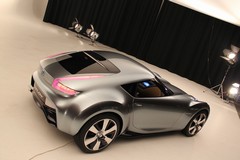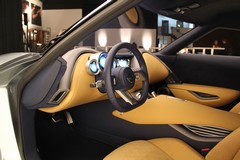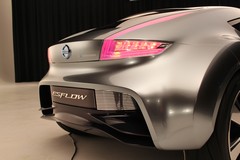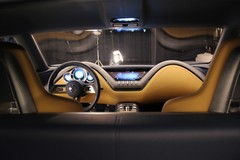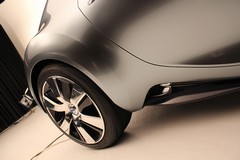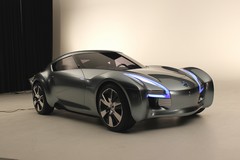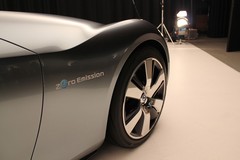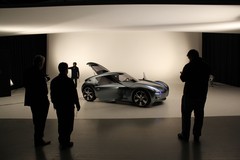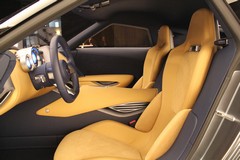Nissan Undecided On Esflow EV
Would a halo sports model help shift EV perceptions?
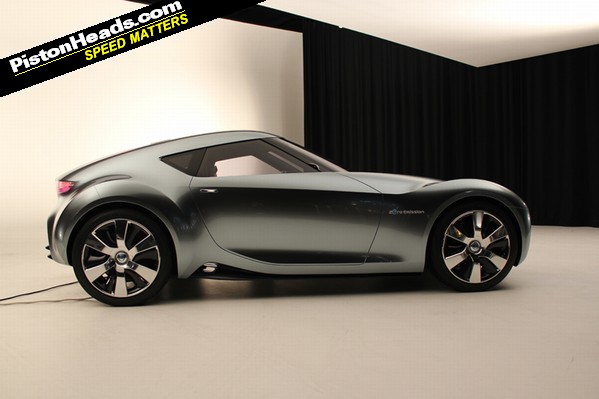
Francois is (deep breath....) 'Division General Manager, Product Strategy & Advanced Product-Planning Director' for Nissan's Zero Emissions line-up, which makes the Esflow his baby. PH met him last week to chat about the concept (due to be unveiled in Geneva next week), and to attempt to separate reality from the hype.
That all-electric aspect is a bit of a red flag for PHers, perhaps, so let's start by imagining this compact rear-wheel drive coupe powered by a proper combustion engine instead. (We'll puncture that balloon for you shortly.) The Esflow is smaller than the 370Z so, while a V6 seems unlikely, a fizzing turbo four might fit.
Would you want one now? Because in the metal and carbon fibre - the concept is an aluminium frame with composite panels - the Esflow is certainly attention grabbing. We're not sure it's quite 'stunning', but what's most interesting is just how outlandish it's not.
Much of the design reflects the current Nissan performance portfolio; the aforementioned Z, obviously, but also the GT-R (check the front wings and visor-like windscreen). The difference, the futurism, comes in the form of sharper creases and slender lighting graphics - both elements that are increasingly a production possibility thanks to modern materials techniques and the ever onwards march of LED headlamps.
According to Monsieur Bancon, we will see similar details on sporting Nissans soon. But the Esflow looks almost ready to roll straight off the factory line. The interior, though outfitted with metal fixtures and carbon fibre mouldings, isn't by any means wacky, while the exterior has proper bumper joins and door shuts.
But Francois is adamant there are no plans for a sub-370Z Nissan sports car with an internal combustion engine. Rear-wheel drive four-pots are difficult to engineer for NVH he says, and Nissan feels it can't deliver a quality product at a competitive price. The idea has been 'studied and studied' in the envious light of Mazda's success with the MX-5, and Francois jokes he has 'no idea how Mazda makes money' on that car.
So why, then, does the Esflow look so... real?
Because Nissan wanted 'absolute credibility on the execution'. The idea for an all-electric sports car has been around since 2005 when CEO Carlos Ghosn gave Nissan's EV strategy the green light. 'Innovation for excitement' is (genuinely) the company motto, and while this can't possibly justify the Micra, Francois says Nissan could build the Esflow 'tomorrow'.
The tricky part is the business case. The underlying electric vehicle technology not only exists, it's in production already as the Esflow uses the same laminated lithium ion battery pack as the Nissan Leaf. That's a T-shaped unit fitted behind the seats and beneath what was formerly the transmission tunnel, and it would be powered by two 80kW (108bhp, 206lb ft) Nissan Leaf motors, mounted in line with the rear axles, each driving one of the rear wheels.
The concept itself - which can apparently move under its own voltage - is powered by a single motor but the twin set up is not only technically feasible, with the right control systems it might even provide profound agility without necessarily doubling the energy consumption. The theoretical 150-mile range is further than the single motor Leaf's official 110-mile capability, yet with a potential 216bhp and 406lb ft the Esflow's ambition is 62mph from standstill in less than 5.0 seconds.
Weight is the key - where the Leaf approaches 1,600kg, the Esflow has a 900kg goal. The concept stretches this slightly to around 1,000kg, but still has a very low centre of gravity thanks to the battery position, while the 47-53 front-rear weight bias approaches Nissan's 45-55 ideal (as per the GT-R).
It could also be affordable. Nissan's target price is 25-30,000 Euros (£25k max) because such a car would have to be accessible. Here, the exotic materials low weight demands aren't so much an issue (this innovation is coming across the car industry within years anyway) as the potential sales volumes. How many 'Daniels' are there in the world? (The cheesy chappie from the original press release dreamed up by Nissan's customer profiling programme.)
The problem is that Nissan wants to achieve a 25 percent share of the total EV market by 2018, and a niche sports car isn't necessarily going to help much with the numbers. The three models already signed off include a commercial vehicle, so EV thrills don't seem very high up the corporate wish list.
But while a small urban EV makes more financial sense than a sports car, a production Esflow could be rationalised as a sexy 'halo' model for electric tech.
The impression we get from Francois is that Nissan is undecided. The Esflow is officially just a concept, but it is going to Geneva with solemn intent - if enough people make enough fuss it might influence the company's priorities.
If nothing else, Nissan's concept implies that you won't need a Tesla-sized budget to have fun in an electric car in future. Sadly though, in spite of its finished appearance, it takes us no closer to understanding what that form of 'fun' may actually feel like.
Words and pics by CJ Hubbard
Gassing Station | General Gassing | Top of Page | What's New | My Stuff

